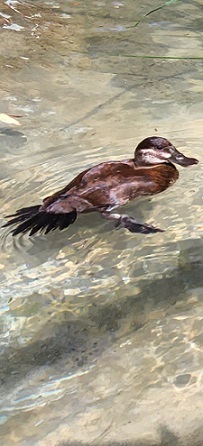Ruddy Duck
Oxyura jamaicensis
- Habitat: Fresh water swamps, lakes, marshes, ponds, estuaries, and lagoons
- Range: North America and the Caribbean Islands
- Natural Diet: Insects, arachnids, crustaceans, grasses, sedges, and pond weeds
- Status In The Wild: Common
All about the Ruddy Duck
Ruddy ducks are a species of duck that are small-sized thick-necked ducks. The females’ plumage is light brown on their breasts and along the sides of their bodies, turning to a darker brown on their heads and along their backs down to their tails. During the non-breeding season, the males and females are monomorphous with the same coloring except for the white cheek patches sported by the male while the female has a dull creamish line across her cheeks. During the breeding season, however, males sport a bold sky-blue bill, shining white cheek patches with black feathers on the top of their heads, and a gleaming chestnut body. They are stiff-tailed ducks stiffly sticking their tail feathers upright. Like other ducks, their beaks are pointed and flattened along the edges. They have short legs that are positioned at the far end of their bodies which is an evolutionary adaptation for swimming. Their webbed feet are another unique adaption that helps them swim more smoothly. These ducks are around a foot in body length and are very light (1 pound).
Diet/ Habitat/ Range
Ruddy ducks are found in North America (Canada, USA, and Mexico) and the Caribbean Islands. Their breeding habitats include marshes, ponds, lakes, estuaries, and bays. They mainly feed on aquatic invertebrates, insect larvae, and mollusks, and on aquatic plants (seeds, roots, tubers, green parts).
Behavior
Ruddies are diving ducks that feed by diving and swimming underwater, using their feet to propel them. They use their beaks to funnel and sieve microorganisms and aquatic invertebrates at the bottom of the ponds/water bodies.
They migrate between their breeding and wintering grounds, mostly at night, in small numbers.
Reproduction
Ruddy Ducks breed once a year. The breeding season lasts from late spring through the summer months. These ducks are either polygamous mating with multiple partners during the breeding season or are seasonally monogamous and pair with one partner during each breeding season. They rarely vocalize, only vocalizing during courtship displays, to attract females. The pair choose a protected place to build their nest, usually in vegetation in their wetland habitat, which helps hide their eggs and ducklings from predators. The female can lay up to 10 eggs in one clutch. The female incubates the eggs and feeds the ducklings for up to 1.5 months till they fledge while the male protects his female and ducklings from predators and competition. The ducklings reach sexual maturity by their second year.
Conservation/Status
Since the Ruddy Duck populations in the wild have been estimated to be currently stable, they are categorized as Least Concern by the International Union for World Conservation.
.jpg)
